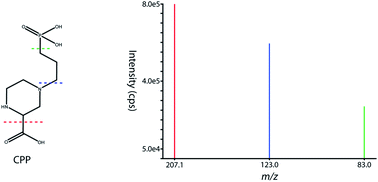Measurement of NMDA receptor antagonist, CPP, in mouse plasma and brain tissue following systemic administration using ion-pair LC-MS/MS
Abstract
(RS)-3-(2-Carboxypiperazin-4-yl)-propyl-1-phosphonic acid (CPP) is a competitive antagonist of the N-methyl-D-aspartate (NMDA) receptor and is routinely used with rodent models to investigate the role of NMDA receptors in brain function. This highly polar compound is difficult to separate from biological matrices. A reliable and sensitive assay was developed for the determination of CPP in plasma and tissue. In order to overcome the challenges relating to the physicochemical properties of CPP we employed an initial separation using solid phase extraction harnessing mixed-mode anion exchange. Then an ion-pair UPLC C18 separation was performed followed by MS/MS with a Waters Acquity UPLC interfaced to an AB Sciex QTrap 5500 mass spectrometer, which was operated in positive ion ESI mode. Multiple reaction monitoring (MRM) mode was utilized to detect the analyte and internal standard. The precursor to product ions used for quantitation of CPP and internal standard were m/z 252.958 → 207.100 and 334.955 → 136.033, respectively. This method was applied to a pharmacokinetic study and examined brain tissue and plasma concentrations following intravenous and intraperitoneal injections of CPP. The elimination half-life (t1/2) of CPP was 8.8 minutes in plasma and 14.3 minutes in brain tissue, and the plasma to brain concentration ratio was about 15 : 1. This pharmacokinetic data will aid the interpretation of the vast number of studies using CPP to investigate NMDA receptor function in rodents and the method itself can be used to study many other highly polar analytes of interest.


 Please wait while we load your content...
Please wait while we load your content...